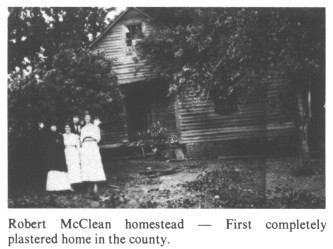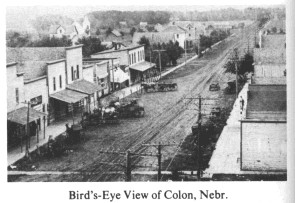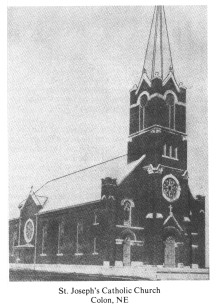CENTER PRECINCT
This precinct was formally organized February 1, 1871. It was formed out of land once called Marietta Precinct. It was named "Center" because it is located very near the center of the county.
This area was settled mostly by Irish people and Czech-Bohemian people and some Germans.
Precinct officers for 1983-87 are Francis J. Divis, Chairman; Robert E. Pecha, Clerk; and N. Kent Pearson, Treasurer.
 |
| Robert McClean homestead - First completely plastered home in the county. |
COLON TOWN HISTORY
Prior to the 1860's the area around Colon was still unsettled, rolling prairie. It was not until the early 1860's that a man named Wall settled near Sand Creek. He stayed only a few years, then sold out and moved on west. Isaac N. Phelps came to Nebraska around 1869 and made special efforts to encourage settlers to remain in this part of the county. When Nebraska first became a state and a search was being made for a suitable site for the capitol, a place a few miles north of Colon was strongly considered. A cement marker was placed on that spot and remained there until it was destroyed by vandals in 1970.
The Saunders County census from 1870-1920 shows that immigration had a great deal to do with the settlement of the county. In 1870 most foreign-born were from Ireland, Sweden, Norway, Germany and English Canada, but by the 1920's the Swedes, Germans and Czechs were dominating the immigration movement to the Colon area of Saunders County. In the 1880's the settlement's population was about 100. It reached a peak of 193 in 1900. In 1910 it was 160, by 1915 it was 175, and in 1982 it had declined to 110.
Colon's first location was about three miles north of the present site. In 1879 the town was relocated to about one mile south of the original location, and a post office was established. In 1886 the town was platted on land which the Chicago Northwestern railroad bought from Martin Van Fleet. Mr. Leander Taylor, with his family and other relatives moved to the new settlement from Colon, Michigan, He named the town "Colon" and when the postoffice was moved to the town it adopted the name "Colon." The town of Colon was incorporated December 1, 1894. One reason for relocating the postoffice was the opening of a new postoffice in Cedar Bluffs, another railroad town just a few miles north. This move helped to evenly divide the area between the Wahoo and Cedar Bluffs postoffices.
In 1890 when John P. Olander came from Sweden and homesteaded here, there were only an elevator and two houses in town. Mr. Olander built the first blacksmith shop in 1890. Other businesses quickly followed, and by the end of 1890 there were two grain elevators, a livery stable, saloon, coal-grain-livestock store, two general mercantile stores and the postoffice. By 1893 a livery hotel, meat market, billiard hall and hardware store were operating.
Although it is difficult to ascertain just what years the various commercial enterprises were in operation, present day senior citizens of the community connect the names of John Murren, Henry White, George Orme, Nyman and Bruce, Alvin Peterson, Harold Bauer, Jim Johnson, George DuBois, Ed Timme and Dave Dwyer with grocery and general merchandise stores; livery stable with Geneway and Jurgens; hardware store with Fritz and Andolph Hanson; grain elevators with Nye-Jenks, Kinsella, Farmers Co-op, and at present Colon Grain Co. with Daryl Nyberg; drug stores with Sid McCaw and George Mowers; garage owner was Henning Nelson; telephone office owned by George Jurgens whose daughters operated the switchboard, as did Mrs. Fred Divis. Dr. McCaw was remembered as a well-liked and respected physician, as was Dr. Bias.
 |
| Bird's-Eye View of Colon, Nebr. |
Telephones came early in the 1900's and Colon was the first town in Saunders County to have the dial system installed.
A Presbyterian Church was built in 1906, and continued to provide services for the community until about 1950 when it was permanently closed. The church was destroyed by fire March 14, 1969.
By 1916 a drug store lumber yard, barber shop and another physician were providing added services to this agricultural community. A. L. Mountain and Forest Poole are remembered as the barbers who kept the men of the community slicked up.
A new two-room school house was built in 1903 when the district was divided. This school district, #117, provided education for grades 1-8 and for some years included two years of high school, continuing with this system until the late 1930's when the high school was discontinued. At present the school provides instruction for children from Kindergarten through eighth grades, employing two teachers. High school age children commute to Cedar Bluffs or Wahoo high schools, with a number of children attending Catholic grade and high schools in Wahoo.
In 1919 the Catholic Church was moved from its rural location northwest of Colon into town. A brick church building was constructed and the church was renamed St. Joseph's Catholic Church. Its history can be found elsewhere in this volume.
A second drug store was added to the business section in 1920, prior to a disastrous fire which destroyed half of the town's commercial buildings. Only two of the early buildings remain today.
Colon is located in a highly productive agricultural area. Its productivity has increased markedly in recent years with the introduction of irrigation, hybrid seeds, fertilizers, and other modern farming practices. At present the town's businesses consist of the Colon Grain Co., State Bank, Starlite Lounge and Restaurant, and the postoffice. One building houses equipment for the state highway department and another for the Lincoln Telephone Company. The Ruzicka Brothers own a large garage-storage building in which they house farming equipment.
St. Joseph's Catholic Church continues to minister to the community and the Colon school maintains its standing as a rural school. Although there have been rumors occasionally of closing the postoffice, it has not happened, and one rural mail route still serves the community. Bob Pearson of Mead is the present carrier. Names of past rural mail carriers include Hollingsworth, Lillie, Newberger, Walt and Ralph Anderson, August Timm, Charles Baily and Carl Nelson.
For many years the Chicago Northwestern rail-
page 56
road provided transportation for cattle and grain to larger markets, and until 1940, passenger service. At one time there were six passenger trains and four freight trains coming through Colon once each day. It is stated that during one period Colon shipped out more grain than any town in Nebraska. This picture changed as large cattle feeding operations and on-the-farm-storage combined to hold much of the grain off the market at peak harvest seasons. Privately owned farm trucks together with the expanding trucking industry created problems for many railroads and the Chicago Northwestern terminated services on this route early in 1982.
As communities grew people banded together to protect their families and properties, so the Colon Fire Department was organized January 29, 1908. Its first fire chief (called foreman in those days), was Henning Nelson. It continued active until 1916, then was inactive until March 1922. At a special meeting November 16, 1925 it was reorganized and continued to function intermittently until 1956, without regular meetings. In 1955 a fire district was organized and a pumper purchased. During that same year the fire department was reorganized and has continued to meet regularly. Eugene Peterson served as fire chief from 1955 to 1980. Bill Hunter was elected chief in 1980 and continues in that position. The department has cooperated with training classes in both firemanship and first aid instruction.
The original fire equipment (1908) consisted of a hose hooked to the hydrant and hand laid to the scene of the fire. Later a hose cart was bought and in early 1920 a chemical truck. In 1930 a new truck chassis was purchased and chemical tanks mounted on it. A new pumper was purchased in 1955, and later two tankers and one small truck for grass fires. At this writing a new pumper is being purchased to replace the 1955 pumper. The building that houses the department's equipment and vehicles was built by the fire district on the north side of main street in 1963-64.
Two Colon men, Arthur E. Adolphson with Expeditionary Forces in France and the Army of Occupation in Germany, and Robert Anderson with the 351 Aero Squadron in France, served our country in World War I. A large number served in World War II.
Two organizations that have contributed much to the community spirit and support are the American Legion Post #265 and its Womens' Auxiliary. Both were organized after the end of World War II -- history to be found elsewhere in this volume. Under the Legion's sponsorship a new meeting hall was built on main street. This has functioned as a meeting place for many large gatherings in the community. The old town hall located next to the Legion Hall, is now the Starlite lounge, but in former years it was the center of much activity, such as school programs, movies on occasion, and other large community affairs. George A. Orme financed the building of the first town hall located on the north side of main street.
Although many of Colon's present day residents commute to work in other areas, the town remains a typical small-town of rural America, strongly supported by agriculture. Through rains, droughts, winds, dust storms, good times as well as bad, the people continue to support each other in various endeavors that improve the quality of life for all. Material Supplied by Sister Rita Bouc and Dagmar Peterson
STATE BANK OF COLON
On April 3, 1899, a meeting was held in the office of the Kinsella Grain Company for the purpose of organizing a bank. F. J. Kirchman was elected President and J. W. Dailey, Cashier. Dailey was succeeded by J. F. Bastar in 1905, and E. H. Henderson in 1921.
A building was erected at a cost of $534.00. In 1907 a brick building was constructed by S. P. Wahlstrom of Wahoo, Nebraska. It was destroyed by fire Febr. 8, 1921, and a new building was built on the same location. Banking operations were held in the Henning Nelson garage during construction. This bank continued in operation until June of 1930, when it was reorganized with a capital and surplus of $30,000.00. Deposits totaled $104,000.00. John Murren was elected President. Anton F. Vasina, who began working as a bookkeeper and Assistant Cashier at the bank upon his return from the Army in 1919 was elected Cashier, a position he held until his death in March, 1958. He was succeeded by his son, Anthony F. Vasina, who now serves as President. Richard J. Vasina is present Cashier and Executive Vice-President. At this time capital and surplus total $280,000.00 and deposits have reached $4,700,000.00 Board of Directors consists of Mary T. Vasina, Anthony F. Vasina, Howard R. Vasina, Richard J. Vasina, and Dorothy Ann Warfield.
ST. JOSEPH'S CATHOLIC
CHURCH
The four original parishes in the early Mission Territory were Malloy Settlement near Cedar Bluffs, Sand Creek or Holy Rosary Church, Estina, and Mead.
These parishes were all served by one priest, the first being Father Fitzgerald from Fremont, Nebraska.
In 1884 the Sand Creek Catholic Church was built four miles south of the Malloy Church. It was built on a plot of ground donated by Sam Howard. This is now the location of the Holy Rosary Cemetery of St. Joseph's Parish.
In 1888 the four parishes in Saunders County agreed to build a rectory in Colon for a resident priest who would serve them. The land was donated by Charles McDermott, Sr. Father Charles Browne supervised the construction of the frame house west of the railroad tracks. It was destroyed by fire in 1910. Another house was purchased from Pat Danahy in Colon, the present rectory of St. Joseph's Church.
 |
St. Joseph's Catholic Church
Colon, NE |
In 1918 the Holy Rosary Church was directed to be closed by Bishop O'Reilly and be rebuilt in Colon. Boundries were formed for the new St. Joseph's Parish in Colon.
John McDermott, Charles T. McDermott and Tim Dailey purchased the lots for the new church. The new Parish was organized in May, 1918 and the Patron Saint, St. Joseph, was chosen in honor of the pastor, Father Joseph Stockinger. In May, 1918 a building committee was elected. They were Tim Dailey, John McDermott, Frank Cech Sr., Mike Rochford and Thomas J. Hrdlicka. They hired H. Brinkman, architect, of Emporia, Kansas. The contract was let to S. P. Wahlstrom. After completion of the foundation, the labor was mostly done by the parishoners.
After the closing of the Holy Rosary Church and until completion of the new church, Mass was offered at the Colon Town Hall.
While Father Stockinger was helping build the church, he stepped on a nail, developed tetanus and died on October 8, 1918, at the age of 38.
Father John O'Sullivan succeeded him and supervised completion of the brick structure that cost $45,000. It was dedicated on November 19, 1919.
The first lay committee serving on the church board were John McDermott and Lloyd Koutny.
In 1946 the interior of the church was completely redecorated and in 1952 an electric organ was installed.
In September, 1958, ground was broken for a new Parish Hall, west of the rectory. It was built under the supervision of the pastor, Father Robert Trausch, who built the kitchen cabinets and did the art work on the walls of the assembly room. The hall was completed on the 40th Anniversary of the building of St. Joseph's Church.
In the spring of 1982 the church was completely renovated. The altars, statues and Stations of the Cross were cleaned and repainted, windows on the outside were waterproofed. A bathroom was installed. New sidewalks and a ramp were installed on the south of the church.
The priests that served St. Joseph's Parish from 1888-1982 are Father Charles Browne; Father L. S. Dumphy; Father O. N. Turgeon; Father C. J. Quinn; Father C. A. Stricker; Father D. J. Cronin; Father M. A. O'Boyle; Father Joseph Stockinger; Father John O'Sullivan; Father Jos. Blacha; Father S. J. Milner; Father O. F. Schlachter; Rt. Rev. Msgr. Jno. Ekeler; Father R. L. Wageman; Father Joseph Sinkula; Rt. Rev. Msgr. S. G. Wagner; Rt. Rev. Msgr. Denis Barry; Father John Zastrow; Father Charles Kottas; Father Thomas Daly; Father Patrick O'Byrne.
ST. WENCESLAUS CEMETERY
St. Wenceslaus is perhaps one of the oldest cemeteries in Saunders County. It is located about one and one-half mile northwest of Wahoo. Wesceslaus Virgl donated the land for it in 1882. One acre was bought later by St. Wensceslaus parish. Past cemetery board members have included Frank Machovecs and Vince Symodynes. Present board members are Joe Hradsky, Joe Benal and Steve Kavan. One of the first persons to be buried in this cemetery was Joe Vybiral, in about 1893.
SCHOOL DISTRICT NO.23
Standard School, more familiarly known to its patrons as Rural Elementary District No. 23, is located in the Northeast corner of the NW¼ of Section 23-15-7. Prior to the autumn of 1871 very few distinct district records were kept in the County Superintendent's office. It appears that District 23 school was not always located at its present site but had its inception in the NW¼ of the NE¼ of Section 26-15-7. The ground, a plot nine rods square, was granted by George W. and Estilla E. Chase on June 12, 1876. Title bonds for the present location were executed July 2, 1883, and land deeded from B. A. Knapp et husband May 13, 1885. It is not quite clear what happened to the building located in Section 26, but a former elderly resident did not recall it ever being moved to the present site and speculated that it had been used as a small granary and animal shelter by an adjacent farmer.
page 57
| 


